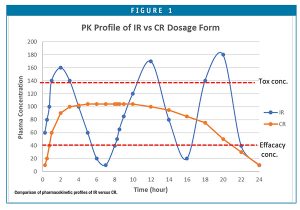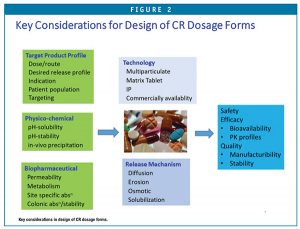Issue:January/February 2021
FORMULATION FORUM - Oral Controlled Delivery of Poorly Water-Soluble Drugs
INTRODUCTION
In the pharma industry, there is a very high failure rate in new drug development. Only one in 5,000 discovery compounds will reach the market. Most failures in early development are mainly due to drug toxicity, safety, and efficacy issues. A significant increase in the percentage of new chemical entities (NCEs) with poor physical, chemical, and biopharmaceutical properties (BCS II and IV) in the drug pipeline has played a significant role in attributing to those high failure rates. Around 50% of drugs on the market and nearly 90% of molecules in the discovery pipeline are poorly water soluble. Poor solubility can lead to low bioavailability, resulting in suboptimal drug delivery, ineffective drug efficacy, and side effects. As a result, various drug delivery nanotechnologies, such as nano-suspensions, lipid microemulsions, nano-emulsions, and amorphous solid dispersions, have been found critical in overcoming these bioavailability challenges faced by the pharma and the biotech industries.
In addition, because immediate-release formulations normally having a wide fluctuation of drug plasma concentration and causing unwanted toxicity and poor efficiency, oral controlled-release formulations, which could maintain a steady concentration of the drug in the plasma within the therapeutic index, have been adapted for early drug development to overcome compound toxicity issues (Figure 1). Controlled-release formulations can optimize the pharmacokinetic and pharmacodynamic properties of drugs, and thus can improve the safety and efficacy of NCEs that otherwise might fail due to safety reasons. In addition, controlled-release dosage forms have proven very useful in lifecycle management of approved drugs via NDA 505(b)(1) or 505(b)(2) regulatory pathways. Reformulation of immediate-release dosage forms with multiple daily doses into a once-daily modified-release product can simplify dosing regimens, improve patient compliance, and enhance product safety.
KEY CONSIDERATIONS FOR CR DOSAGE FORM DESIGN
Every NCE possesses its unique properties that require special considerations for rational design of a CR drug delivery system. CR dosage form development should define its target pharmaceutical profiles based on medical need, physiochemical/ biopharmaceutical properties, and applicability of formulation technology. Figure 2 shows the key considerations for design of CR dosage forms.
TARGET PHARMACEUTICAL PROFILES
The main goals in early phase modified-release dosage form development is to enhance efficacy by increasing duration of Cmin plasma concentration above the effective concentration and to minimize toxicity by reducing the Cmax plasma concentration to below the toxicity level. In addition, controlled release can reduce the dosing frequency and thus improve patient compliance. The modified-release duration varies between 2 to 24 hours depending on the goals of the CR dosage form: 1) if the CR formulation is needed to blunt the Cmax plasma concentrations in order to reduce Cmax-related side effects, a 4- to 6-hour delivery will be sufficient; 2) if a CR formulation is to improve efficacy by increasing duration of Cmin above the efficacious concentration and to reduce dose frequency, a 6- to 24-hour release will be desirable depending on the drug body half-life and regional absorption of the drug in the lower GI tract; and 3) if a CR formulation is to reduce local irritation or to avoid drug degradation in the gastric fluid, a delay release of ~2 hours will be sufficient.
When designing a CR dosage form, ease of administration, dose accuracy, and swallowability should be always considered for specific patient populations, including for Alzheimer’s disease, pediatric, and geriatric populations. Multi-particulate dosage forms, such as coated beads and powder for reconstitution, are popular for those populations due to ease of swallowing and reproducibility in drug-release rate.
Depending on body half-life, regional absorption in the GI tract, dose/solubility, bioavailability, matrix type, or membrane-coated CR dosage forms can be selected for development with an aid of modeling and simulation.
BIOPHARMACEUTICAL CONSIDERATIONS
An ideal candidate for CR dosage form has the following biopharmaceutical properties:
- Adequate solubility in the physiological pH range
- Minimal first-pass metabolism
- Uniform absorption throughout GI tract (no site specificity)
- Optimal partition coefficient (log PC o/w > 1.0)
- Low dose (< 500 mg)
- Short half-life (4 to 8 hours)
- Relatively high therapeutic index
A compound that has difficulty for CR dosage form development has the following properties:
- High first-pass metabolism
- Large dose (> 500 mg)
- Site-specific absorption
- Drug having narrow therapeutic index
- pH dependent solubility/low aqueous solubility
SOLUBILITY
For compounds with low water solubility, even though drug absorption of the original crystalline form is generally extended due to the slow drug dissolution, it is not an ideal way to achieve modified release by controlling API particle size because of potential variation in particle size distribution for different batches and potential issues in poor bioavailability. It will be challenging to develop a CR dosage form for compounds with low solubility at a high dose level (dose/solubility >250). One way to resolve the issue is to use enabling formulation technologies, such as Ascendia’s nanotechnology platoforms, such as NanoSol, AmorSol, and EmulSol, to enhance API solubility, and thereafter to incorporate the active soluble intermediate into a CR dosage form.
STABILITY
Compounds that are unstable in GI tract (various pH levels) and are subject to enzymatic degradation in the GI tract should consider ways to stabilize the compound by using a buffer, protecting reagent and coating the API. A compound that is subject to colonic microflora digestion should not consider drug release in the lower GI tract with a release duration longer than ~6 hours.
PERMEABILITY
For BCS class III drugs, absorption of drug is limited by its permeability through the GI tract membrane, whereas for BCS class IV drugs, drug dissolution and permeation influence drug absorption. Absorption enhancers and solubility enhancement should be utilized for enhancement of the drug absorption of BCS class IV drugs.
RATIONAL DESIGN OF CR DOSAGE FORMS
The overall design and development process for controlled-release dosage forms of insoluble drugs can be divided into the following steps: (1) to enhance the solubilities and dissolution rates as to the bioavailability of insoluble drugs; and (2) to incorporate the drug intermediate with enhanced solubility in an oral controlled-release dosage form, wherein the drug-release rate is controlled by the dosage form other than by the intrinsic low solubility of the API. Figure 3 shows the decision tree for rational design of CR dosage form for fast translation of discovery compounds into the clinic.
CR formulation development normally go through the following steps:
- Definition of the target pharmaceutical profile and unmet medical need.
- Assessment of drug physical-chemical and biopharmaceutical properties relevant to CR dosage form design and paper feasibility analysis.
- Modeling and simulation to define the dose and the drug-release profiles.
- Selection of an appropriate CR technology and in vitro test methods to evaluate formulations with different release rates that bracket the target release rate in vitro.
- Identification of controlled-release mechanisms that are suitable for the compound under study. Drug-release mechanism includes osmotic pressure, matrix system, and reservoir system. Drug release of different release mechanisms involve desorption from surface; diffusion through the matrix; diffusion through coated membrane; matrix erosion; and a combined erosion and diffusion process. For insoluble drugs, its bioavailability could change with different release mechanisms as drug absorption is influenced by the way of dosage form distribution in the GI tract and the site of drug release.
- In vivo study in animal or human models using prototype formulations with different release rates.
- Development of in vitro/in vivo relationship (IVIVR) or correlation (IVIVC) to aid product development and to obtain a BE waiver for SUPAC changes.
SUMMARY
Controlled-release formulations improve the safety and efficacy of NCEs that otherwise might fail due to safety and efficacy reasons. Controlled-release dosage forms have proved useful in life cycle management of approved drugs via the NDA 505(b)(1) or 505(b)(2) regulatory pathways. Rational design of CR dosage forms for insoluble drugs involves: (1) to enhance the solubilities and dissolution rates as to the bioavailability of insoluble drugs; (2) to incorporate the drug intermediate with enhanced solubility in an oral controlled-release dosage form.
Understanding of key biopharmaceutical properties in relationship to drug absorption and elimination plays a critical role in successful design of CR dosage forms from discovery to first-in-human with a shorter timeline and lower development costs.
To view this issue and all back issues online, please visit www.drug-dev.com.

Jim Huang, PhD
Founder & CEO
Ascendia Pharmaceuticals
j.huang@ascendiapharma.com
www.ascendiapharma.com

Total Page Views: 6933













